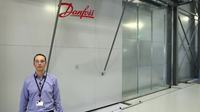Silence worth millions
Fascinating DanfossSilence worth millions
Behind this wall in Flensburg, Germany, is Danfoss' new semi-anechoic test-chamber. Anechoic means echo-free or non-reflective.
Inside, we emit and measure electromagnetic waves. The purpose? Let’s have a look.
All absorbing walls
There
are no echoes here. Silence reigns. Metal walls, covered with a special type of
ceramic material called ferrite, prevent electromagnetic noise entering from outside
the chamber. And more than 350 absorption plates, on the walls, ensure that electromagnetic
waves are not reflected inside.
This makes it the perfect place for us to measure how much electromagnetic noise our Drives emit while operating – and how resistant they are to electromagnetic noise from other sources.
This makes it the perfect place for us to measure how much electromagnetic noise our Drives emit while operating – and how resistant they are to electromagnetic noise from other sources.
Facts: Did you know?
Facts: Did you know?
Electromagnetic waves are all around us.
hhhhh
Fullscreen
There are several natural sources, including the sun
and lightning. Manmade sources include equipment that transmits data and signals,
for example cell phones, TVs, and microwave ovens. The waves can interfere
with, or cause malfunctions in, different kinds of electronic products.
You measure the frequency of electromagnetic waves in hertz (Hz). One wavelength per second equals 1 hertz. A million wave lengths per second equals 1 megahertz (MHz).
You measure the frequency of electromagnetic waves in hertz (Hz). One wavelength per second equals 1 hertz. A million wave lengths per second equals 1 megahertz (MHz).
hhhhh
Turning it in all directions
Before testing, we attach the Drives to a
test-bench placed on the chamber’s five-meter-wide and fully automatic
turntable. The table is built into the floor and can rotate 360 degrees.
Why this is smart? It enables us to measure how much electromagnetic noise the Drives emit from different angles. And if the amount is too high, we immediately go back to the drawing board. None of our Drives ever hit the market, if they emit noise that is even close to the limits specified by international drives standards.
According to these standards, maximum allowed noise levels must be similar to or lower than the reception level of an average FM radio.
Why this is smart? It enables us to measure how much electromagnetic noise the Drives emit from different angles. And if the amount is too high, we immediately go back to the drawing board. None of our Drives ever hit the market, if they emit noise that is even close to the limits specified by international drives standards.
According to these standards, maximum allowed noise levels must be similar to or lower than the reception level of an average FM radio.
These antennas catch everything
We
have nine very special and very expensive antennas here. You can see one of
them in the foreground. The antennas enable us to measure electromagnetic noise
from 9 kilohertz to 18 gigahertz – and to generate noise from 80 megahertz to 6
gigahertz. The spans are huge. As a comparison, the FM radio in your car only
covers 87 to 107 megahertz.
So, we both measure electromagnetic noise from our Drives and expose them to it. That way, we can make sure that noise from the Drives is well below a level where it can cause any disturbance – and that they can withstand noise in any environment they may operate in.
The chamber is roughly 25 meters long, 12 meters wide and nine meters high.
So, we both measure electromagnetic noise from our Drives and expose them to it. That way, we can make sure that noise from the Drives is well below a level where it can cause any disturbance – and that they can withstand noise in any environment they may operate in.
The chamber is roughly 25 meters long, 12 meters wide and nine meters high.
"This is a fantastic chamber. It offers clear benefits - for us and for our customers."
Tim Flintholm Fink, Director, Test & Engineering Support in Danfoss Drives.
Tim Flintholm Fink, Director, Test & Engineering Support in Danfoss Drives.
Facts: Did you know?
Facts: Did you know?

If all electric motor systems were equipped with drives, the world would use 10 percent less energy than today.
Fullscreen
Our
Drives – which we test in this chamber – help make the world greener. How? They
control the speed of electric motors in applications ranging from factory
production lines to supermarket refrigeration systems worldwide. Here, they cut
down energy-use by making sure that the electric motors never run faster than
necessary.
Scroll down to continue
Swipe to continue
Swipe to continue




















 Silence worth millions
Silence worth millions


 Did you know?
Did you know?



 Did you know?
Did you know?

